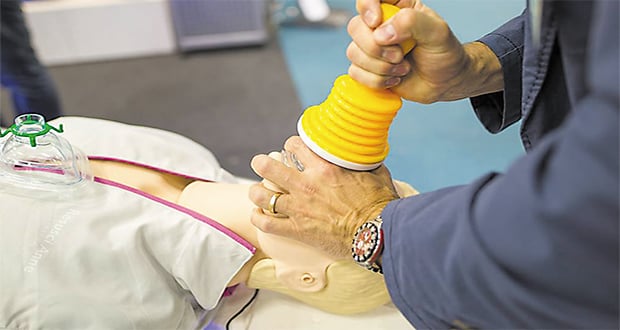How to reduce the risks of choking for the people you support with Dysphagia, and details of a NEW innovative new anti choking product which 1880 UK care homes have already invested in.
June is Dysphagia Awareness month and so all month we have been focusing on different ways we can help you if you are supporting people with Dysphagia.
Today we are talking about choking, how to reduce the risks of choking, some general advice to support people to eat safely -
And an innovative new anti choking device.
When somebody begins to choke, virtually everyone around them will start to panic.
This is because nearly everyone has experienced the feeling of terror when an object becomes stuck in their airway and they cannot breathe.
When this happens, time is of the essence before the person becomes unconscious. If the obstruction is not removed, brain death is expected after just 10 minutes due to lack of oxygen.
Placing things such as tubes or fingers into the mouth is dangerous due to the risk of pushing the obstruction further back or causing oral damage.
People with swallowing difficulties and/or learning disability have a further increased risk of choking and every year people with swallowing difficulties die from choking while eating and drinking which could be prevented.
It is important that people are provided with choking awareness training to empower them to keep themselves safe. However some people will need ongoing support to recognise the health and safety aspects of eating and drinking, for example, the amount they can eat safely, the temperature, rate of intake and presence of inedible.
Others are unable to fully understand their risk of choking and rely solely on support to foster a safe eating environment, promote safe eating strategies, and encourage safe food choices.
It is important to ensure that people who have swallowing difficulties or who have a choking risk are clearly known with adequately trained staff available to supervise and support.
Useful tools to alert staff include care plan, Personal Place Mat, bedside notice or swallowing report. If the person is on a modified dysphagia diet, check the food provided is the correct consistency, temperature and is prepared as recommended. Be cautious that no hard skin has formed.
Ensure you have up to date swallowing awareness, first aid and choking awareness training. Ensure you are aware of, and follow local choking guidelines and/or policy. Record and report all choking events, use the choking event form. This will help you learn from choking events to help prevent further choking. Remember that if a person collapses while eating or immediately after eating, you should consider the possibility of choking.
1880 UK care homes have also invested in LifeVac: - an innovative non-invasive anti choking Class 1 medical device registered with the MHRA and CE accredited.
It is designed with a patented one way valve system which creates one-way suction to safely and effectively remove the lodged food or object.
Since the invention of LifeVac, it has saved the lives of 31 people who were choking to death when standard choking protocol has failed in the USA, Canada, UK, Greece and Spain.
Choking protocol (back blows, abdominal thrusts and CPR) is only 70% effective when performed correctly by professionals. For people that are wheelchair users, this statistic drops drastically due to being unable to receive the abdominal thrusts or back blows if they are seated in a moulded wheelchair.
1880 care homes in the UK have already equipped themselves with this device to improve resident safety.
Being non invasive means there is no risk of damaging the oral cavity, pushing the obstruction further down, pushing the tongue back in a panic situation, no tubes can become blocked rendering the device useless or activating the gag reflex putting the casualty at greater risk.
LifeVac is the only non invasive airway clearance device and the only airway clearance device with independent medical testing, peer reviewed medical publications, medical abstracts proving safety, effectiveness and lives saved.
For more information and to view and purchase our brand new range of LifeVac products, please visit our website at www.hcsuk.co.uk





